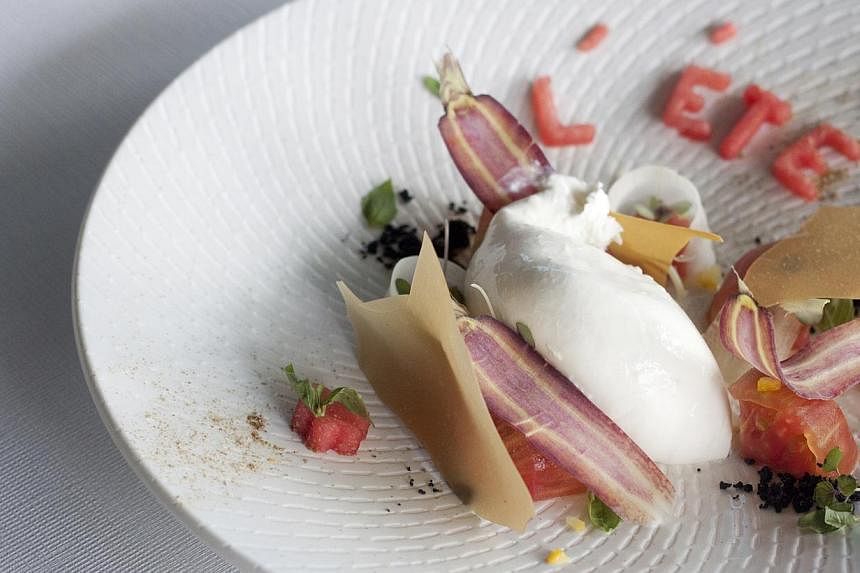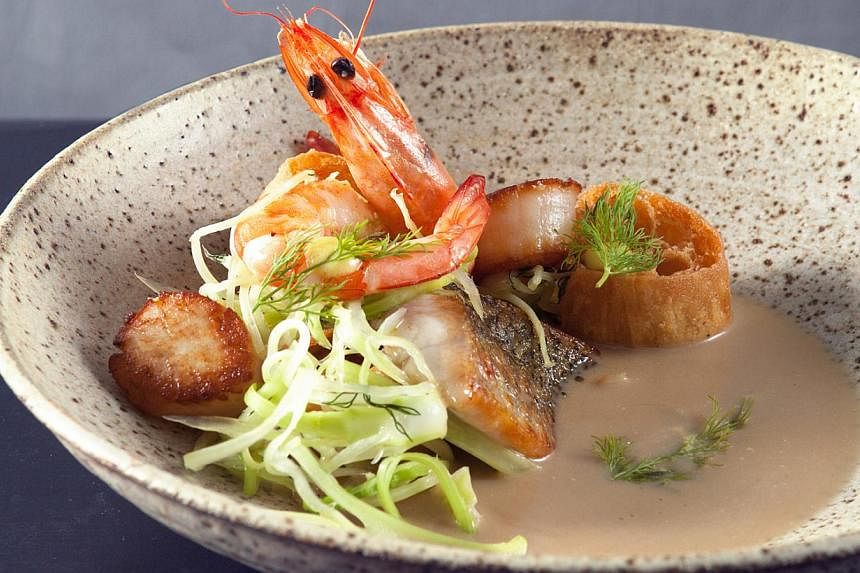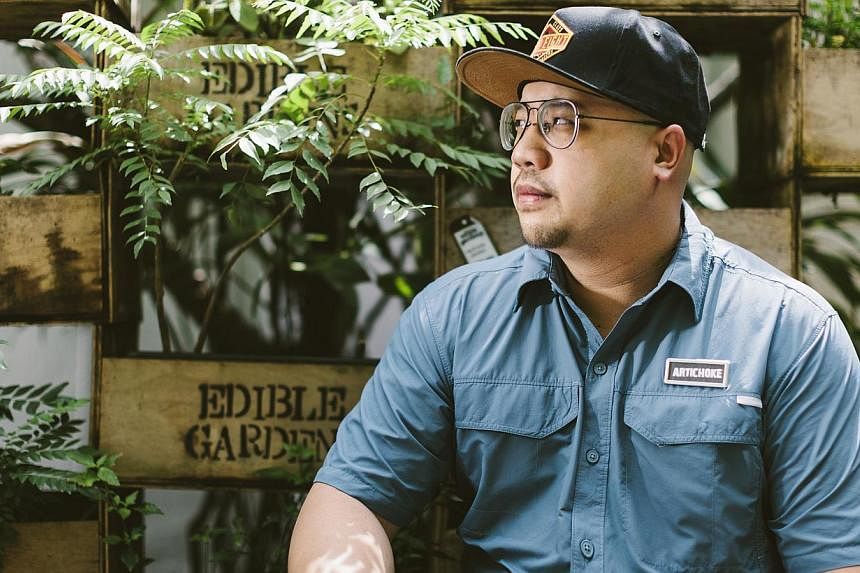Many diners who headed to new restaurant Seasons Bistro at TripleOne Somerset last month were curious about the seafood on their plates and where it came from.
While only about three in 10 diners were there because they knew about the week-long Sustainable Seafood Festival the restaurant was participating in - the bistro was one of about 30 restaurants - the other diners, many of whom knew nothing about sustainability, became interested in the subject.
The restaurant's executive chef Benjamin Fong, 32, says all the restaurant's seafood comes from sustainable sources.
He adds: "The festival helped to raise awareness about the sustainability of seafood. Some asked about the origin of the seafood and the meaning of sustainability."
The well-received festival, which took place between June 8 and 15, was organised by the World Wide Fund for Nature Singapore in partnership with fishery certification body Marine Stewardship Council (MSC), a non-profit organisation.
In simple terms, sustainability is about not depleting stocks, replenishing and maintaining ecological balance and not being harmful to the environment, says marine biologist Alistair Douglas, 43.
He is also an auditor for Best Aquaculture Practices, an aquaculture industry certification by the Global Aquaculture Alliance, an international organisation dedicated to the advancement of environmentally and socially responsible aquaculture.
Over the past two years, chefs and restaurateurs say they have noticed more diners asking about the ingredients on their plate.
This could be because sustainability is the new food buzzword, or because food sourcing and food safety have been making headlines recently. Either way, restaurateurs and chefs say this increased awareness is a good thing.
A handful of chef-restaurateurs and hotels here are dedicated to the philosophy of sustainability. Some pride themselves on getting produce from farmers that practise traditional and sustainable farming methods, while others work with farms to grow vegetables to their specifications.
The Naked Finn in Gillman Barracks sources its line-caught lingcod, chinook salmon and spot prawns from a sustainable fishery in Alaska, while The Market Grill gets its lobsters from a sustainable producer in Canada.
Chef Andre Chiang of nouvelle French restaurant Restaurant Andre gets artisanal vegetables grown in Taiwan. The vegetables, which travel a shorter distance than those from France, arrive fresher.
Ask chefs why they bother with sourcing sustainable products either themselves or through suppliers, or even growing some things themselves, and they say they do it because every bit counts.
Portico, a restaurant in Alexandra Road that serves European fare, grows its own herbs and some vegetables.
Its executive chef Leandros Stagogiannis, 35, says: "Sustainability is important for future generations. We are here at the mercy of nature. Animals and vegetables are giving their lives for our lives and I think it's important to give them that due respect."
Chef-owner of Artichoke in Middle Road, Bjorn Shen, 32, says: "It makes me feel better. It sounds simple but it's better than ordering ingredients off a list. There is such a disconnect with that.
"When you taste the product at the source, you feel as if you are part of the process and, for me, this adds a cognitive level to my job."
He visited a small farm in Lim Chu Kang last Thursday and purchased 2kg of salad greens, which he included in his menu that very night. It took three hours of his time, but it was worth the effort, he says.
Items are fresher and, as a result, there is less wastage due to damaged products. The carbon footprint is also reduced, which is better for the environment.
Chef Janice Wong, 31, of 2am:dessertbar and catering arm 2am:experience, heads to Oh Chin Huat Hydroponic Farms off Semabawang Road to get herbs, flowers and, well, weeds.
She usually has an ice box with her and snips a variety of basil flowers, tarragon flowers, verbena leaves or whatever is best that day, and goes only when she needs to - for instance, when she has to cook a special dinner or when a guest chef is in town. "It is important that we do not deplete the resources," she says.
"The herbs are pesticide-free and knowing that is very important. People think our stuff is from overseas but it isn't. Sourcing local produce is very inspiring and the produce always tells a story."
She used to order flowers from overseas but no longer does so.
Mr Allan Lim, 42, chief executive of urban farm Comcrop, is working on an initiative to bring chefs and local farmers together so more chefs will be locavores.
"When it's local, we can harvest on the day of delivery. We want to support food security and emphasise that it is important to be more environmentally sustainable such as cutting away food miles by buying from local producers."
Getting vegetables from Malaysia or nearby countries in Indochina is also more sustainable than ordering from Europe.
Indeed, more chefs are jumping on the bandwagon and increasing their use of sustainable ingredients.
At the Grand Hyatt Singapore hotel, 70 per cent of the seafood it uses at its food-and-beverage outlets is sustainable, as certified by independent third-party bodies including the MSC and Friends Of The Sea. Its executive chef Lucas Glanville, 45, hopes to have only sustainable sources in time.
For banquets at the Sands Expo and Convention Centre, there is the option of a Green Harvest Menu, created with sustainable ingredients from Singapore, Indonesia, Thailand and Malaysia.
Over at French restaurant Jaan at Swissotel The Stamford, about 60 per cent of chef Julien Royer's menu is sustainable.
The 31-year-old says: "The shift (towards sustainable produce) needs to be made now - and as chefs, our role is partly to educate people."
But then there is also the question of price.
Sustainably farmed, caught or reared produce can also be more expensive. Depending on quantity and quality, it can cost between 30 and 200 per cent more, chefs say.
Mr Wee Teng Wen, 34, director and co-founder of The Lo & Behold Group, whose Tanjong Beach Club restaurant recently worked with The Naked Finn to roll out a barbecue with sustainable seafood, says: "In my opinion, wild-caught seafood generally tastes better. With greater room to move, the taste and texture of the seafood is improved. While we would love to serve more food from sustainable sources, quality is our No. 1 priority, so it often comes down to a delicate balance between accessibility and cost."
Over the years, the consumption of shark's fin has also been increasingly frowned upon because of the overfishing of certain shark species and inhumane finharvesting processes, during which fishermen cut off the shark's fin while it is still alive then toss it back for a painful death. However, there is some dispute over whether this is a common practice.
Last week, Singapore Airlines Cargo, a subsidiary of Singapore Airlines, announced that it will stop freighting shark's fin from next month, while last month, integrated resort Marina Bay Sands vowed to stop selling and serving shark's fin at the restaurants it owns and operates.
Many top hotels here have taken the "no shark's fin" stance. Some choose to take it off menus and make it available on request only, while others, like Hilton Worldwide, have banned it since April.
There are, however, sustainable sources of shark's fin. But more will need to be done by restaurants and hotels keen to use it.
The long-term vision, Dr Douglas says, is for the ethos of sustainability to become ingrained in society.
He says: "Some certification bodies may be more rigorous than others. However, all of them are essentially helping to move us in the right direction."
Mr Wee of The Lo & Behold Group adds: "I believe everyone has a shared responsibility to preserve our food sources for future generations. It's not always easy but every bit adds up."
Follow Rebecca Lynne Tan on Twitter @STrebeccatan
SUSTAINABLE DISHES
ARTICHOKE
What: The restaurant uses a range of sustainably sourced items including eggs, mushrooms and vegetables produced here; and tomatoes and herbs from its garden. It serves a Moroccan-style whole barbecued fish using locally farmed tilapia (market price); fried cauliflower with mint and coriander from the restaurant's garden ($18) and house-smoked chicken ($26) with garden herbs and vegetables that range from curry leaves to branches of the surinam cherry plant.
Where: 161 Middle Road, tel: 6336-6949
Open: 6.30 to 9.45pm (Tuesday to Saturday), 11.30am to 2.45pm for brunch (weekend), closed on Monday
Info: www.artichoke.com.sg
THE NAKED FINN
What: The seafood restaurant does not serve species of seafood that are threatened or in danger of becoming overfished. These include Atlantic halibut and Patagonian toothfish (also known as Chilean seabass), says its owner, Mr Tan Ken Loon. Some of its sources include the restaurant's prawn farm in Sri Lanka, which uses organic feed and underground water to decrease the natural lagoon's water salinity. Sustainable fish include line-caught chinook salmon.
Where: 41 Malan Road, Gillman Barracks, tel: 6694-0807
Open:Noon to 2pm (weekday lunch), noon to 3pm (Saturday brunch), 6 to 10pm (Monday to Thursday dinner), 6 to 8pm and 8.15 to 10pm (Friday and Saturday dinner); closed on Sunday
Info: www.nakedfinn.com
PORTICO
What: It uses locally farmed seabass in dishes such as fish and chips; Duo Of Seabass, in which the fish collars and belly, seasoned with just salt and lemon juice, are grilled over a Japanese barbecue; pan-seared seabass fillet with new potatoes, herbed beurre blanc and Granny Smith apple and herbs from the restaurant's garden. Its herbs are also used in various salads and desserts. Prices range from about $10 to $25 a dish.
Where: 991B Alexandra Road, 01-10, tel: 6276-7337
Open: 11.30am to 3pm, 5.30 to 11.30pm (Tuesday to Saturday), 9.30am to 3pm (Sunday), closed on Monday
Info: www.portico.sg
JAAN
What: The restaurant's sustainable fish include rainbow trout, seabass and grouper, which are part of its set menus. A five-course degustation menu featuring confit of rainbow trout is priced at $198 a person. Chef Julien Royer is now working on a dish using sustainable spanner crab from Australia's Fraser Island. He also uses herbs from Fairmont Singapore and Swissotel The Stamford's joint garden, which produces organic herbs including thyme, rosemary and tarragon.
Where: Swissotel The Stamford, 2 Stamford Road, Level 70, Equinox Complex, tel: 6837-3322
Open: Noon to 2.30pm, 7 to 10pm (Monday to Saturday), closed on Sunday
Info: E-mail reservations@equinoxcomplex.com or go to www.jaan.com.sg
OPEN DOOR POLICY
What: The restaurant uses local vegetables in its wagyu burger ($32) and locally farmed seabass in its bouillabaisse (above) that also includes prawn, scallops, squid and baby fennel ($28).
Where: 19 Yong Siak Street, tel: 6221-9307
Open: Noon to 3pm, 6 to 10pm (Wednesday to Friday), 11am to 3pm, 6 to 10pm (weekend), closed on Tuesday
Info: www.odpsingapore.com
OCEAN RESTAURANT BY CAT CORA
What: Resorts World Sentosa says the fish in some of its dishes are from sustainable sources. These include roasted monkfish ($60), served with black olive oil, chorizo puree and ratatouille; and the buttered fried red gurnard ($52), with Scottish mussels, mussel-basil emulsion, dill cream and preserved lemon. They are available for dinner only. For lunch, the restaurant also serves crispy skin barramundi ($22), with Parma ham floss and apple celeriac slaw, with fish from a farm in Penang.
Where: Resorts World Sentosa, S.E.A. Aquarium, tel: 6577-6688
Open: 11.30am to 3.30pm, 5.30 to 10.30pm daily
Info: E-mail dining@rwsentosa.com
SAINT PIERRE
What: Dishes made with sustainable ingredients include the Burrata D'ete Pour Deux ($56, serves two), with momotaro tomato, yuzu zest, fleur de sel, watermelon, vanilla, black olive dust, arlette chard, micro vegetables, sweet basil and sansho pepper; and the Boeuf Aux Carottes ($48), 48-hour braised beef rib on the bone with popped quinoa, cherry tomato, courgette, porcini gratin, veal jus reduction, sprouted seeds and fresh peas. The burrata is from an artisan Italian farmer who makes the cheese with milk from cows he owns and milks by hand, while the beef is from a small butcher in England whose grass-fed cows are raised traditionally and hand-selected based on maturity before being slaughtered.
Where: 31 Ocean Way, Quayside Isle, 01-15, tel: 6438-0887
Open: 5.30 to 9.30pm (Tuesday to Friday), 11.30am to 2.30pm, 5.30 to 9.30pm (weekend), closed on Monday
Info: www.saintpierre.com.sg
GRAND HYATT SINGAPORE
What: About 70 per cent of the seafood at the hotel, including its food-and-beverage outlets such as Straits Kitchen and mezza9, is from sustainable sources that have been certified by independent third-party agencies or organisations such as the Marine Stewardship Council and Friends Of The Sea. The hotel is also moving towards using pasture-fed beef which is hormone free, as opposed to grain-fed cows which are usually kept in feed lots.
Where: Grand Hyatt Singapore, 10 Scotts Road, tel: 6732-1234







